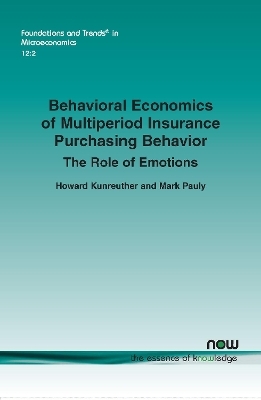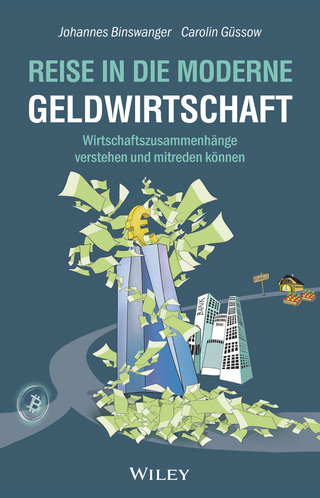
Behavioral Economics of Multiperiod Insurance Purchasing Behavior
The Role of Emotions
Seiten
2018
now publishers Inc (Verlag)
978-1-68083-524-3 (ISBN)
now publishers Inc (Verlag)
978-1-68083-524-3 (ISBN)
Demonstrates that emotions play a role in predicting departures from expected utility maximization for making insurance purchasing decisions over time. The authors highlight the conceptual issues and alternative theories of behaviour about repeat insurance purchasing over time.
Addresses the question of how potential insurance buyers make decisions like these by considering the conceptual and empirical evidence that address the following theoretical and behavioral issues: the extent that consumers tend to follow the multiperiod decision rules based on expected utility [E(U)] maximization; and the factors that influence their choices when they do not behave as if they are maximizing E(U).
The principal contribution of this monograph is to demonstrate that emotions play a role in predicting departures from expected utility maximization for making insurance purchasing decisions over time. The authors highlight the conceptual issues and alternative theories of behavior about repeat insurance purchasing over time and the empirical literature on the proportion of consumers that buy coverage after loss-producing events only to cancel their insurance as those events become more distant in time.
The monograph then details the findings from novel web-based experiments that seek to determine whether people change their insurance decisions after experiencing a loss when offered a relatively high, medium or low premium relative to the expected loss. Section 2 reviews the empirical evidence on deviations from rational thinking, especially as they relate to choices about repeated purchase over time. It also discusses the interplay between cognitive biases generated by intuitive thinking and emotions in changing insurance purchase decisions over time. Section 3 details an experiment in the context of hypothetical hurricane damage where individuals are told that loss probabilities and premiums remain the same from period to period. Section 4 details an experiment where participants must choose between high-deductible health insurance at a given premium and low-deductible health insurance at a higher premium, and explores whether they will switch from one policy to the other over time. Section 5 draws together the findings, and provides guiding principles of insurance and recommendations for public-private partnerships to address the cognitive biases noted in Section 2 via a behavioral risk audit that encourages more deliberative thinking with respect to insurance-related choices.
Addresses the question of how potential insurance buyers make decisions like these by considering the conceptual and empirical evidence that address the following theoretical and behavioral issues: the extent that consumers tend to follow the multiperiod decision rules based on expected utility [E(U)] maximization; and the factors that influence their choices when they do not behave as if they are maximizing E(U).
The principal contribution of this monograph is to demonstrate that emotions play a role in predicting departures from expected utility maximization for making insurance purchasing decisions over time. The authors highlight the conceptual issues and alternative theories of behavior about repeat insurance purchasing over time and the empirical literature on the proportion of consumers that buy coverage after loss-producing events only to cancel their insurance as those events become more distant in time.
The monograph then details the findings from novel web-based experiments that seek to determine whether people change their insurance decisions after experiencing a loss when offered a relatively high, medium or low premium relative to the expected loss. Section 2 reviews the empirical evidence on deviations from rational thinking, especially as they relate to choices about repeated purchase over time. It also discusses the interplay between cognitive biases generated by intuitive thinking and emotions in changing insurance purchase decisions over time. Section 3 details an experiment in the context of hypothetical hurricane damage where individuals are told that loss probabilities and premiums remain the same from period to period. Section 4 details an experiment where participants must choose between high-deductible health insurance at a given premium and low-deductible health insurance at a higher premium, and explores whether they will switch from one policy to the other over time. Section 5 draws together the findings, and provides guiding principles of insurance and recommendations for public-private partnerships to address the cognitive biases noted in Section 2 via a behavioral risk audit that encourages more deliberative thinking with respect to insurance-related choices.
1. Introduction
2. Impact of Intuitive Thinking on Purchasing Insurance and Mitigation
3. Dynamic Insurance Decision-Making for Rare Events: The Role of Emotions
4. Responses to Losses in High Deductible Health Insurance: Persistence, Emotions, and Rationality
5. Improving the Decision Making Process
References
| Erscheinungsdatum | 08.01.2019 |
|---|---|
| Reihe/Serie | Foundations and Trends® in Microeconomics |
| Verlagsort | Hanover |
| Sprache | englisch |
| Maße | 156 x 234 mm |
| Gewicht | 162 g |
| Themenwelt | Wirtschaft ► Volkswirtschaftslehre ► Mikroökonomie |
| ISBN-10 | 1-68083-524-6 / 1680835246 |
| ISBN-13 | 978-1-68083-524-3 / 9781680835243 |
| Zustand | Neuware |
| Haben Sie eine Frage zum Produkt? |
Mehr entdecken
aus dem Bereich
aus dem Bereich
Wirtschaftszusammenhänge verstehen und mitreden können
Buch | Softcover (2023)
Wiley-VCH (Verlag)
19,99 €
die psychologischen Determinanten menschlicher Entscheidungen
Buch | Softcover (2024)
Kohlhammer (Verlag)
39,00 €


